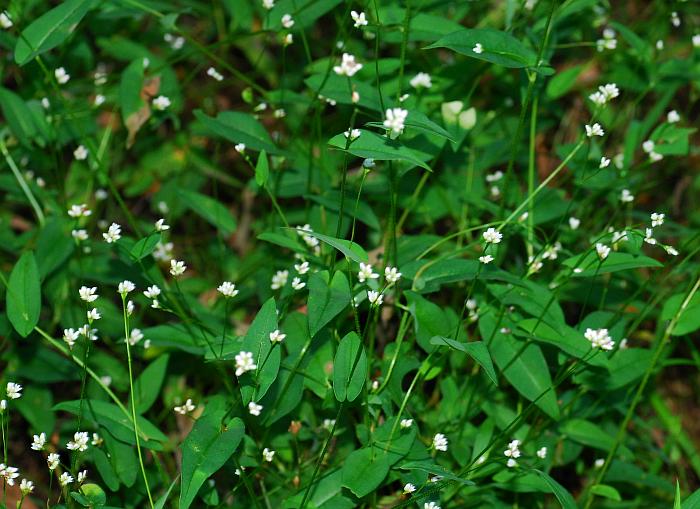Persicaria sagittata (L.) H. Gross
Arrow-Leaved Tear-Thumb

Native
CC = 4
CW = -5
MOC = 46
© SRTurner
Persicaria sagittata (L.) H. GrossArrow-Leaved Tear-Thumb | |
 |
Native CC = 4 CW = -5 MOC = 46 |
© SRTurner |
|
Family - Polygonaceae Habit - Taprooted annual forb, sometimes rooting at lower nodes. Stem - Ascending, spreading, or climbing, to 2 m, glabrous but armed with small, downwardly hooked prickles. Ocreae mostly persistent, 5-13 mm long, cylindric, tan or brownish, papery, unarmed at the base, the margin entire or with erect bristles 0.2-1.0 mm, the surface glabrous.
Leaves - Petioles 0.5-4.0 cm long. Leaf blades 2.0-8.5 cm long, 1-3 cm wide, broadly oblong-lanceolate to arrowhead-shaped, cordate or auriculate at the base, tapered to a pointed tip, the margins otherwise entire, but sometimes hairy, the surfaces glabrous or moderately to densely appressed-hairy, the undersurface sometimes also minutely prickly along the main veins, lacking a reddish or purplish area on the upper surface.
Inflorescences - Terminal and axillary, solitary or grouped into small panicles, 0.5-1.5 cm long, 4-12 mm wide, dense and headlike, uninterrupted, the stalk 1-8 cm long, usually glabrous, occasionally prickly toward the base. Ocreolae usually overlapping, the margins smooth, not gland-dotted. Flowers 2 or 3 per fascicle.
Flowers - Perianth white or greenish white, sometimes pinkish-tinged, bell-shaped, not gland-dotted, the tepals 5, 3-5 mm long, fused below the midpoint, the nerves not prominent, not anchor-shaped. Stamens 8, not exserted, the anthers pink. Styles 3-branched above the midpoint, not exserted, not persistent.
Fruits - Achenes 2.5-4.0 mm long, 1.8-2.5 mm wide, not exserted, 3-angled, beakless, the faces flat or slightly concave, the surfaces smooth or minutely pitted, brown to black, shiny or dull. Flowering - June - October. Habitat - Bottomlands, swamps, sloughs, fens, pond margins, moist swales, ditches. Origin - Native to the U.S. Lookalikes - Persicaria arifolia. Other info. - This easily recognized plant has been collected from about 40% of Missouri counties, predominantly in the eastern half of the state. Its U.S. distribution includes most of the eastern half of the country, with a few scattered disjunct populations farther west. Photographs taken at Young Conservation Area, Jefferson County, MO, 8-30-2016 (SRTurner). |